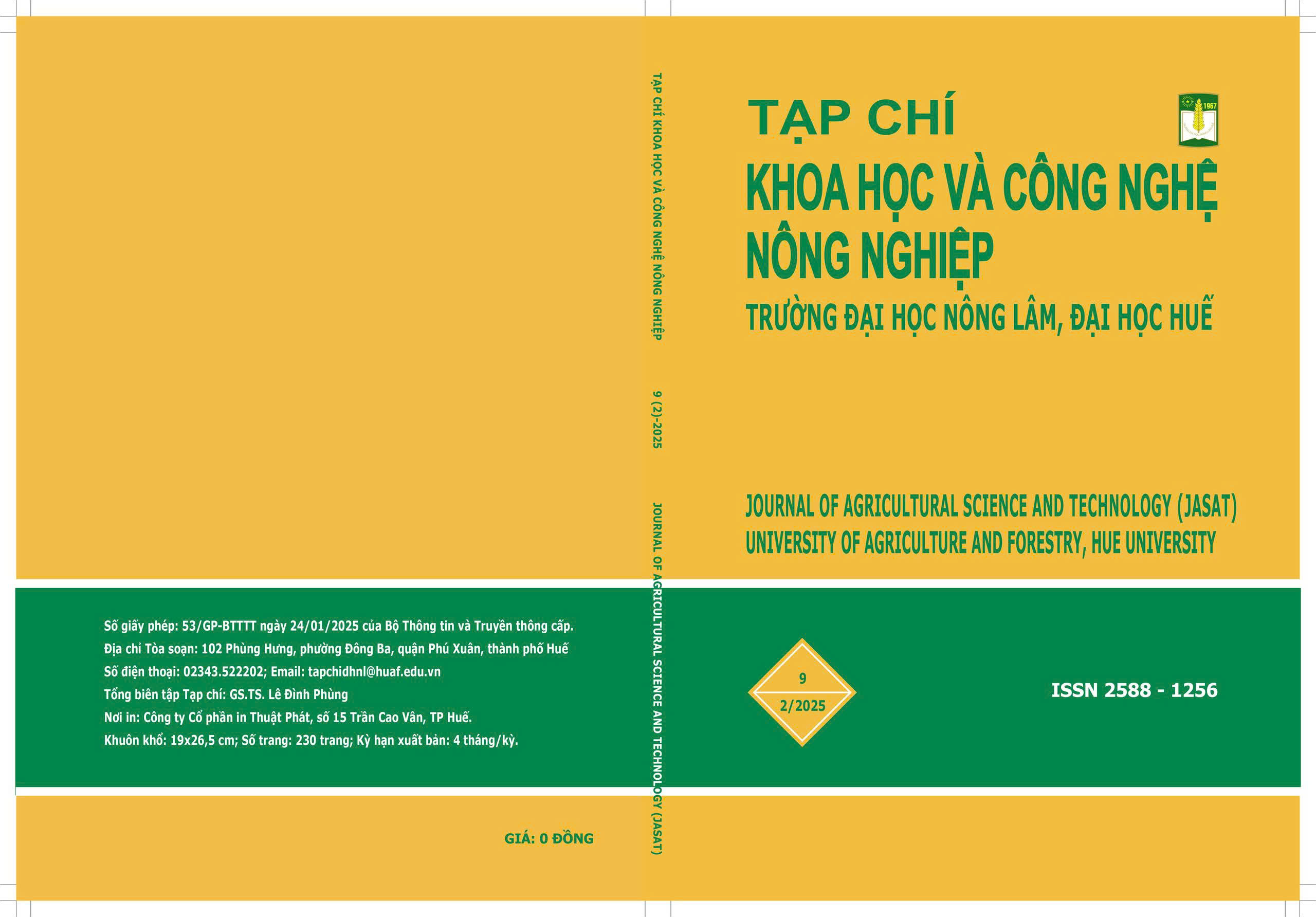##plugins.themes.huaf_theme.article.main##
Tóm tắt
Nghiên cứu này được thực hiện nhằm khảo sát các yếu tố công nghệ ảnh hưởng đến chất lượng sản phẩm mứt jam phối trộn giữa gấc (Momordica cochinchinensis Spreng.) và chanh dây (Passiflora edulis Sims.), bao gồm: tỷ lệ phối trộn nguyên liệu, hàm lượng đường phèn, tỷ lệ pectin và thời gian cô đặc. Kết quả cho thấy công thức thích hợp cho sản phẩm mứt jam đạt chất lượng cao là tỷ lệ phối trộn gấc:chanh dây = 1:3 (w/w), bổ sung 60% đường phèn, 1,5% pectin, cô đặc trong 15 phút ở 70°C. Sản phẩm đạt độ ẩm 40,85%, độ Brix 65,90, pH 3,27, hàm lượng vitamin C 157,97 mg/100g, và có màu sắc đỏ cam đặc trưng với L* = 35,60; a* = 27,23; b* = 13,36. Sản phẩm không phát hiện vi sinh vật gây hại và được đánh giá cảm quan đạt tổng điểm 16,30/20, trong đó hương vị và cấu trúc được người tiêu dùng đánh giá cao nhất. Kết quả này khẳng định tiềm năng chế biến mứt jam từ gấc và chanh dây không chỉ nâng cao giá trị sử dụng mà còn góp phần đa dạng hóa sản phẩm thực phẩm.
##plugins.themes.huaf_theme.article.details##
Tài liệu tham khảo
Ahmed, J., Shivhare, U. S., & Kaur, M. (2002). Thermal colour degradation kinetics of mango puree. International Journal of Food Properties, 5(2), 359–366.
Basu, S., & Shivhare, U. S. (2010). Rheological, textural, micro-structural and sensory properties of mango jam. Journal of Food Engineering, 100(2), 357–365.
Basu, S., Shivhare, U., & Raghavan, G., 2007. Time dependent rheological characteristics of pineapple jam. International Journal of Food Engineering, 3(3), 1–8.
Bhumsaidon, A., & Chamchong, M. (2016). Variation of lycopene and beta carotene contents after harvesting of gac fruit and its prediction. Agriculture and Natural Resources, 50(4), 257–263.
Borsarelli, C. D., & Mercadante, A. Z. (2009). Thermal and photochemical degradation of carotenoids. In Carotenoids: Physical, Chemical and Biological Functions and Properties. CRC Press
Chuyen, H. V., Nguyen, M. H., Roach, P. D., Golding, J. B., & Parks, S. E. (2015). Gac fruit (Momordica cochinchinensis Spreng.): a rich source of bioactive compounds and its potential health benefits. International Journal of Food Science & Technology, 50(3), 567–577.
Gupta, N., Bandral, J. D., Sood, M., Dutta, U., Sharma, A., Trilokia, M., Hameed, F., & Nayyar, P. (2022). Influence of sugar concentration on quality characteristics of Bael jam during storage. Agricultural Mechanization in Asia, Africa and Latin America, 53(4), 7419–7428.
Jay, J. M., Loessner, M. J. & Golden, D. A. (2005) Modern Food Microbiology. 7th Edition, Springer Science and Business Media, Inc., New York, 63-90, 101-125.U.S.
Kim, M. J., Yoon, S. H., Jung, M. Y., & Choe, E. O. (2008). Effects of sugars and pectin on the quality characteristics of low sugar wild vine (Vitis coignetiea) jam. Korean Journal of Food and Cookery Science, 24(2), 206-211.
Kopjar, M., Piližota, V., Nedić Tiban, N., Šubarić, D., Babić, J., Ačkar, Đ., & Sajdl, M. (2009). Strawberry jams: Influence of different pectins on colour and textural properties. Czech Journal of Food Sciences, 27(1), 20–28.
Kubola, J., & Siriamornpun, S. (2011). Phytochemicals and antioxidant activity of different fruit fractions (peel, pulp, aril and seed) of Thai gac (Momordica cochinchinensis Spreng.). Food Chemistry, 127(3), 1138–1145.
Kurotobi, T., Hoshino, T., Kazami, Y., Hayakawa, F., & Hagura, Y. (2021). Influence of physical properties on the taste and flavor of strawberry jam. Journal of Texture Studies, 52(2), 260–274.
Lim, Y. Y., Lim, T. T., & Tee, J. J. (2007). Antioxidant properties of several tropical fruits: A comparative study. Food Chemistry, 103(3), 1003–1008.
Mari, A., Parisouli, D. N., & Krokida, M. (2024). Exploring osmotic dehydration for food preservation: Methods, modelling, and modern applications. Foods, 13(17), 2783–2805.
Meda, A., Lamien, C. E., Romito, M., Millogo, J., & Nacoulma, O. G. (2005). Determination of the total phenolic, flavonoid and proline contents in Burkina Fasan honey, as well as their radical scavenging activity. Food Chemistry, 91(3), 571–577.
Pereira, Z. C., dos Anjos Cruz, J. M., Corrêa, R. F., Sanches, E. A., Campelo, P. H., & de Araújo Bezerra, J. (2023). Passion fruit (Passiflora spp.) pulp: A review on bioactive properties, health benefits and technological potential. Food Research International, 166, 112626–112646.
Robinson, A. L., Ebeler, S. E., Heymann, H., Boss, P. K., Solomon, P. S., & Trengove, R. D. (2009). Interactions between wine volatile compounds and grape and wine matrix components: Influence on aroma compound headspace partitioning. Journal of Agricultural and Food Chemistry, 57(21), 10313–10322.
Saha, D., & Bhattacharya, S. (2010). Hydrocolloids as thickening and gelling agents in food: A critical review. Journal of Food Science and Technology, 47(6), 587–597.
Schotsmans, W. C., & Fischer, G. (2011). Passion fruit (Passiflora edulis Sim.). In E. M. Yahia (Ed.), Postharvest Biology and Technology of Tropical and Subtropical Fruits, 4, 125–142. Woodhead Publishing.
USDA, Department of Agriculture, Agricultural Marketing Service. (1980). United States standards for grades of fruit preserves (jams). Washington, DC.
Vuong, L. T., & King, J. C. (2003). A method of preserving and testing the acceptability of gac fruit oil, a good source of β carotene and essential fatty acids. Food and Nutrition Bulletin, 24(2), 224–230.
Wang, J., Law, C. L., Mujumdar, A. S., & Xiao, H. W. (2017). The degradation mechanism and kinetics of vitamin C in fruits and vegetables during thermal processing. Drying Technologies for Foods (Chapter 12, 276–301).
Zhao, X., Zhou, Y., Liu, J., Chen, J., Ye, F., & Zhao, G. (2020). Effects of sucrose on the structure formation in high-methoxyl apple pectin systems without acidifier. Food Hydrocolloids, 105, 105783.


